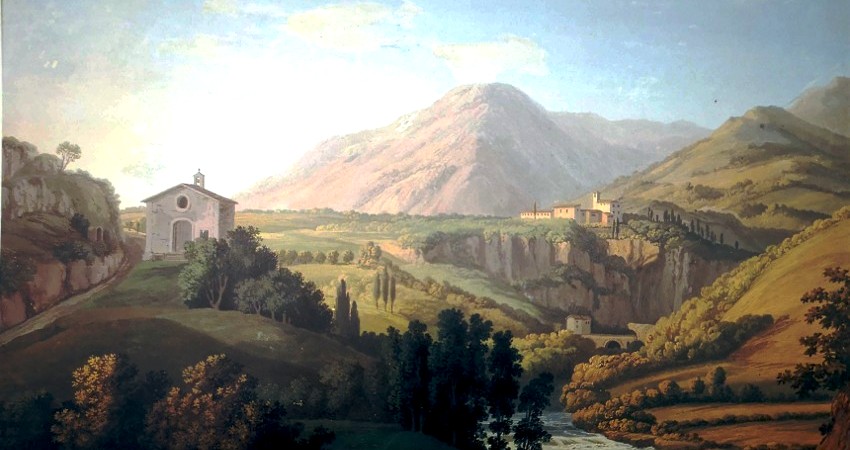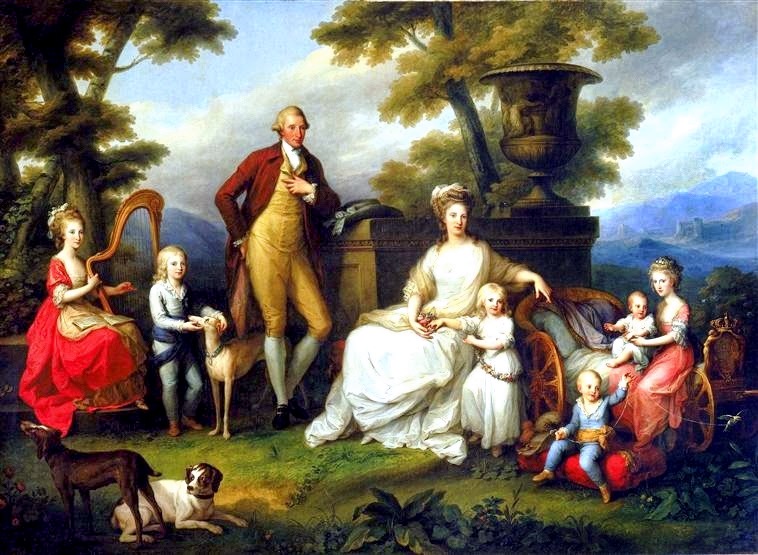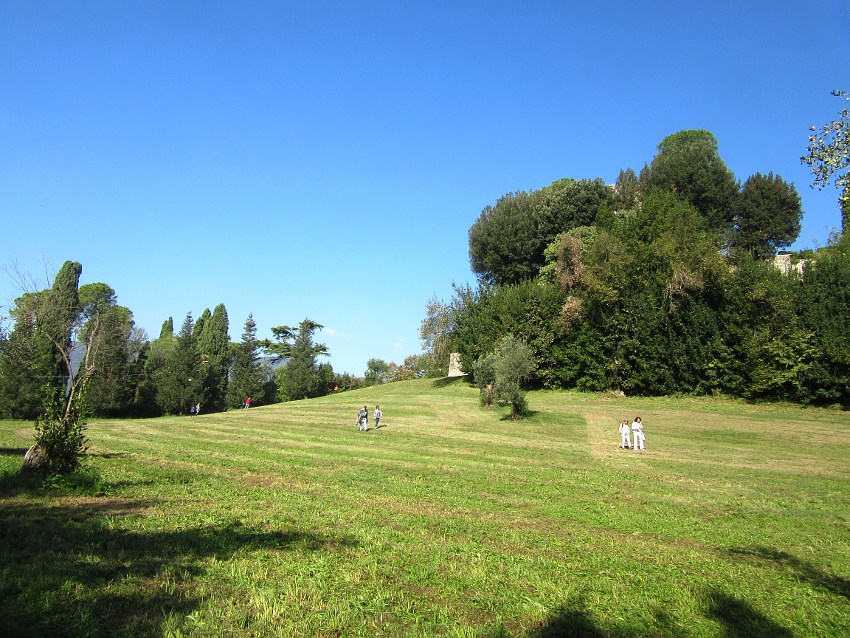History of the Gardens
The Landscapes of History
The «Ideal View» and the European aesthetics in the 18th Century


The charming landscape has Pre Roman and Ancient Roman origins which explain why art and people have been fascinated by it, especially in times of peace, when the area was not being used as an outpost because of its strategic importance, commanding the access to the East of Rome and the aqueducts carrying Rome’s main water supply.
Owing to its cooler summer temperatures and an abundance of water, this area of the Aniene valley has long been considered a summer place of residence not too far from Rome.
At Tivoli there were the imperial summer villas of Hadrian, Nero and Trajan, and of many senators such as Brutus, Cassius and Cicero are there, as well as the grand residences of Rome’s princely families; notably, there are also the most famous Renaissance fountain gardens of Villa d’Este, supplied by the waters of the River Aniene.
On the gentle slopes around the Castle, not far from Tivoli, lie the ruins of both the pre-Roman cyclopic walls (some may be seen) of the outpost of the Aequii people, of Indo-European origin, and of the Pagus Mandela, the ancient Roman settlement which was there since the Romans defeated the Aequii in the 5th Century BC.
It is also where Horace had one of his farms, and is the place referred to by the Latin poet in his letters. In his first Epistle (Ep.1 Letter XIV), Horace describes the countryside around Pagus Mandela and talks of enjoying his walks at the foot of these slopes, along the Digentia river (tributary of the Aniene) when staying at his own summer villa nearby, around the year 1BC.

Hackert painted ten watercolours, "Vues de la campagne d’Horace", a series of paintings of the countryside surrounding Horace’s summer villa, which are beneath or in the area around the Castle.
This collection became famous and set the new rules on landscape painting and composition in Europe in the 18th century.
While in the 17th century Poussin and Lorrain thought that the ideal views were to be found generally in the Roman countryside, in the 18th century, according to Hackert, the ideal landscapes (ideallandschaft) were to be found in the countryside surrounding Horace’s villa and farms, in the Aniene River Valley, which are partly around Mandela (still Roman countryside). Hackert stated that the picturesque views of the valley had all the elements needed for a successful composition of a landscape, and that these were all in the right place and represented the new ideal views to paint and draw.

As we said, the collection of watercolours became famous and eventually ended up in an international intrigue.
Hackert painted these views for his own pleasure and not under commission, while normally artists would work only under commission until with the impressionist movement artists would begin to paint for their own research and pleasure.
At that time Hackert was working on an important commission for Prince Borghese, but he was unhappy with the subjects he was asked to paint, having more to do with the grandeur of the family, rather than what he thought was good to portray. As soon as he could, he would escape out of Rome to draw what he liked and that is how these guaches came to be painted.
They were later purchased by the Queen of Naples as a gift for her sister Queen Marie Antoinette of France. The two queens (both daughters of Queen Marie Theresa of Austria) were to be told that the watercolours ended up in a shipwreck.
After this loss, King Gustav III of Sweden, whom Hackert had met in Sweden twenty years before at the beginning of his career, asked Hackert to engrave the same views of the watercolours (beautifully engraved by Dunker), which were so successful that a second collection started circulating, unauthorized by Hackert and engraved by Morel.
50 years ago the watercolours were found and are now in the Goethe’s museum in Dusseldorf, Germany.
By the time Hackert came to live in Italy, he was already famous as the new master of landscape painting. His activity and his new vision of the picturesque landscape was of general interest especially with the international intelligentsia on their Grand Tour in Rome, such as Johann Winkelmann, Angelika Kaufmann and Wolfgang Goethe, who were his friends.
Reporting Hackert’s activity in this area was Wolfgang Goethe, who was his admirer and student, Goethe wrote extensively of his painter friend and of his school in Licenza (near Mandela) and about his teaching techniques that was sketching the views during the day
and the study of them in the evenings:
«Yet I find it hard to decide which are the more entertaining, our days or our evenings. As soon as our imposing landlady has placed the three-branched brass lamp on the table with the words “Felicissima notte!” we sit down in a circle and each brings out the drawings and sketches he has made during the day».
Goethe, Italian Journey, 15th novembre 1786.
After the school experience, when Goethe came back to Rome after a trip to Naples and Sicily, Hackert and Goethe went back to this area just the two of them. In the family we have always known that the two lodged for a few days in a part of the Castle, which is now called Goethe’s House, or Lodge. We know this also because one of Goethe’s nieces, Valerie von Wagner, married into the family and there is a fresco of her riding side-saddle in the grounds (Room of the Three Musqueteers).
Camille Corot (who drew an ideal “Garden of Horace”) and people like Johann WInkelmann and Angelica Kaufmann all came to see the views and the area of Horace’s villa.
Lord Byron, part of this international intelligentsia in Rome, came to see, as we read in Childe Harolde:
«At the end of the valley, towards the Anio, there is a bare hill, crowned with a little town called Bardela. At the foot of the hill the rivulet Licenza flows...»
(Note: Bardella was the name of the area of the Castle until the end of the 19th century)

It was in this rich historical context that Alessandro and Julie Bonaparte decided to border with trees the beautiful landscapes identified by Hackert as ideal views, where to host Julie’s international literary salon.
When the del Gallo’s took over the property at the beginning of the 19th century, the first Marquis, Luigi del Gallo, was friends with some members of the international intellighentia, such as Angelika Kaufmann and was the president himself of literary Academy (Accademia Tiberina).
His son, Alessandro del Gallo, married Julie Bonaparte. Julie held a literary salon in Paris, at the time of Napoleon III, her cousin, and then in Rome and at Mandela in the summer season.
The new couple decided to border the views loved by Hackert with oaks, holms, cypresses and horse chestnuts, which have grown to a magnificent size today. Their idea was to turn the beautiful views into a naturally landscaped parkland where to host their intellectual and artist friends. They did this without doing much earth work at all, which is important because all romantic gardens in the English style in Europe and England were created to look natural, as we can see in many of Capability Brown’s beautifully landscaped parklands, which set the fashion for this type of garden to the rest of Europe.